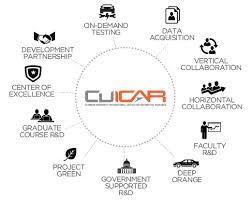Here’s to blue skies, white clouds — and 3D printing.
No matter what you might think of BMW, it’s usually guaranteed that with their modern, sleek designs, you have to sneak a peak on the roadway whether you want to admit it or not. It’s hard to dispute that they do represent a class act on the streets, and they are forever one-upping past designs. This year, students at Clemson University were able to be part of that, putting a new spin on the ultimate driving machine for the fourth annual Deep Orange project.
 Sponsored by BMW, the German maker of superior automobiles also got to set the rules. And you know that made it über challenging, as well as over-the-top interesting — especially with the inclusion of 3D printing technology to put a whole new stamp on the project.
Sponsored by BMW, the German maker of superior automobiles also got to set the rules. And you know that made it über challenging, as well as over-the-top interesting — especially with the inclusion of 3D printing technology to put a whole new stamp on the project.
Did you know that some of the finest students in our country are busy obtaining both masters degrees and PhDs in automotive engineering at Clemson? In wondering how automotive giants come up with the amazing designs and innovations that blow our minds annually with crazy-cool new cars, perhaps we should look toward the talented minds graduating each year from the only graduate department for automotive engineering, which is part of Clemson University, at their International Center for Automotive Research (CU-ICAR). This special and privileged group of students must complete participation in the Deep Orange project to attain their graduate degrees.
While Clemson University is famous in its own right and draws an enormous pool of applicants each year, the Deep Orange proj ect is a draw all on its own. Each year, the research center and its students and professors work with an industry leader to develop a new automotive prototype that demonstrates what is usually breathtaking innovation, combined with new processes that must take environmental, cultural, and financial aspects into consideration as well. The program is referred to as ‘a vehicle prototype program for the pioneering education, research and industry collaboration within the graduate degree programs in automotive engineering.’
ect is a draw all on its own. Each year, the research center and its students and professors work with an industry leader to develop a new automotive prototype that demonstrates what is usually breathtaking innovation, combined with new processes that must take environmental, cultural, and financial aspects into consideration as well. The program is referred to as ‘a vehicle prototype program for the pioneering education, research and industry collaboration within the graduate degree programs in automotive engineering.’
With a ‘transformative vehicle’ in mind, BMW chose their X3 model for students to create a variation on in their challenge. Once they set their goals of establishing who would be expected to buy the vehicle and what their design objectives were, the next step was to create a prototype. These days, when we hear the word prototype, 3D printing is often not far behind. This was exactly the case as students began looking into the costs behind developing a transformative prototype for the X3 which they initially thought would be completed with steel stamping in a process that uses pieces of large sheet metal. Not only were quotes for completing the prototype far too high for their budget, the timeframe would not work with their deadlines. The bottom line was clear: they needed to save time and money.
“Even with the excellent relationships we have with manufacturing suppliers, it didn’t make sense to steel stamp these large parts,” said Bill Sowerby, Deep Orange program director. “Once the students realized traditional manufacturing was out of the question, they had to go back and rethink how to design and build the prototype.”
One of the student team members suggested the option of 3D printing for more rapid manufacturing of their parts. They sent design files to  RedEye, a division of Stratasys, and received a quote that amounted to a staggering 75 percent less, with a preparation time that would deliver the product three to four months sooner than going with the traditional route of steel stamping.
RedEye, a division of Stratasys, and received a quote that amounted to a staggering 75 percent less, with a preparation time that would deliver the product three to four months sooner than going with the traditional route of steel stamping.
“My team and I were facing the challenge of getting the parts built in the shortest possible time within budget constraints. We investigated alternate options and talked with various body shops. But we ultimately chose FDM because the cost and time to make all the parts was drastically lower than the conventional sheet metal forming processes,” commented Ashish Dubey, project manager for Deep Orange 4.
The decision was made to use Stratasys Fused Deposition Modeling (FDM) due to strong engineering-grade thermoplastics for use with large parts. While they had to adjust some of the design to go with 3D printing, they were able to consult with RedEye for advice on how to work with the new technology within the constraints and goals for their project.
“FDM is a very different process than steel stamping so the redesign was important. I helped the Clemson students determine the best orientation and placement for the bonding joint to ensure we would accurately build and weld the parts together to meet dimensional accuracy,” said Eric Quittem, senior project engineer at RedEye. “With thicker walls, we also knew there would be some slight stair stepping on the surface of the parts which is inherent with the layering process. This was new to the Clemson team and we reassured them that the layer lines could be removed with secondary operations.”
To use 3D printed parts and part with traditional prototyping processes, the students faced design refinements in changing angles and wall thickness, and came up with ways to split some of the larger pieces into separate pieces with dovetail joints. With their vision for a compact crossover with pickup capabilities, they needed a smaller SUV that would also offer gas efficiency as well as allowing users to put larger items in the innovative rear bed. Coming up with a design to build a pickup truck-like option into the back meant putting their heads together for both transformative functionality and space.
 For the project, RedEye built 14 parts using ABS-M30 material to include:
For the project, RedEye built 14 parts using ABS-M30 material to include:
- Four pieces of the tailgate.
- Four pieces for the side frames.
- Four pieces for the roof and rear window.
- Two side panels.
“The final parts were as good as it can get in terms of geometric dimensioning and tolerances (GD&T). Overall it was great working with the RedEye team and at the end of the day we got a chance to learn about a new technology which could very well be the future of low volume production parts,” said Dubey.
This ‘new’ BMW X3 ended up featuring:
- A sliding roof to change the trunk into an area somewhat like a pickup.
- A rear window for passenger protection during truck mode and to allow an option for folding down to make more space.
- Convertible rear seats which can be made to lie flat to accommodate pickup mode.
- Hinged rear doors to function for tailgate-like purpose.
Is this a BMW you would like to own? How do you see 3D printing affecting the automotive industry overall? Tell us about it in the 3D Printed BMW forum over at 3DPB.com.
Subscribe to Our Email Newsletter
Stay up-to-date on all the latest news from the 3D printing industry and receive information and offers from third party vendors.
You May Also Like
Gorilla Sports GE’s First 3D Printed Titanium Cast
How do you help a gorilla with a broken arm? Sounds like the start of a bad joke a zookeeper might tell, but it’s an actual dilemma recently faced by...
Nylon 3D Printed Parts Made More Functional with Coatings & Colors
Parts 3D printed from polyamide (PA, Nylon) 12 using powder bed fusion (PBF) are a mainstay in the additive manufacturing (AM) industry. While post-finishing processes have improved the porosity of...
$25M to Back Sintavia’s Largest Expansion of Metal 3D Printing Capacity Since 2019
Sintavia, the digital manufacturing company specializing in mission-critical parts for strategic sectors, announced a $25 million investment to increase its production capacity, the largest expansion to its operations since 2019....
Velo3D Initiates Public Offering in a Bid to Strengthen Financial Foundations and Drive Future Growth
Velo3D (NYSE: VLD) has been among a number of publicly traded 3D printing firms that have attempted to weather the current macroeconomic climate. After posting a challenging financial report for 2023,...































